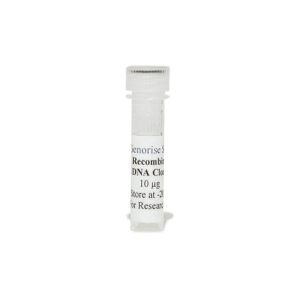Recombinant Human CRP Protein
$99.00 – $2,285.00
The recombinant human CRP protein is derived from in vitro expression of human CRP gene in E. coli and purified using his-tag affinity column and can be used in multiple applications such as cell culture, ELISA and western blot.
Alternative names for CRP: C reactive protein
This product is for Laboratory Research Use Only not for diagnostic and therapeutic purposes or any other purposes.
- Description
- Product Citations
- Reviews (0)
Description
Genorise Recombinant Human CRP Protein Summary
Alternative names for CRP: C reactive protein
Product Specifications
| Purity | > 97%, by SDSPAGE under reducing conditions and visualized by silver stain. |
| Endotoxin Level | < 0.1 EU per 1 μg of the protein by the LAL method. |
| Activity | na |
| Source | E. coli derived human CRP. |
| Accession # | P02741 |
| N-Terminal Sequence Analysis | Met |
| Amino Acid Sequence | Met1-Pro224 |
| Predicted Molecular Mass | 25 kDa |
| SDS-PAGE | 25 kDa, reducing conditions |
Background:
C-reactive protein (CRP) is a protein found in the blood, the levels of which rise in response to inflammation (i.e. CRP is an acute-phase protein). CRP was first identified as a substance in the serum of patients with acute inflammation that reacted with the C-polysaccharide of Pneumococcus. Its physiological role is to bind to phosphocholine expressed on the surface of dead or dying cells (and some types of bacteria) in order to activate the complement system via the C1Q complex.[1] CRP is synthesized by the liver[2] in response to factors released by macrophages and fat cells (adipocytes).[3] It is a member of the pentraxin family of proteins.[2] C-reactive protein was the first pattern recognition receptor (PRR) to be identified.[4] CRP rises up to 50,000-fold in acute inflammation, such as infection. It rises above normal limits within 6 hours, and peaks at 48 hours. Its half-life is constant, and therefore its level is mainly determined by the rate of production (and hence the severity of the precipitating cause).
CRP is used mainly as a marker of inflammation and infection. Measuring CRP level is a screen for infectious and inflammatory diseases. Rapid, marked increases in CRP occur with inflammation, infection, trauma and tissue necrosis, malignancies, and autoimmune disorders. Because there are a large number of disparate conditions that can increase CRP production, an elevated CRP level does not diagnose a specific disease. An elevated CRP level can provide support for the presence of an inflammatory disease, such as rheumatoid arthritis, polymyalgia rheumatica or giant-cell arteritis. However, CRP level is an independent risk factor for atherosclerotic disease. Patients with high CRP concentrations are more likely to develop stroke, myocardial infarction, and severe peripheral vascular disease.[5]
Reference
- Thompson D, Pepys MB, Wood SP (1999). Structure 7 (2): 169–77
- Pepys MB, Hirschfield GM (June 2003). J. Clin. Invest. 111 (12): 1805–12.
- Lau DC, Dhillon B, Yan H, et al. (May 2005). Am. J. Physiol. Heart Circ. Physiol. 288 (5): H2031–41.
- Mantovani A, Garlanda C, Doni A, Bottazzi B (January 2008). J. Clin. Immunol. 28 (1): 1–13.
- Clearfield MB (2005). The Journal of the American Osteopathic Association 105 (9): 409–16.
Product Citations
Be the first to review “Recombinant Human CRP Protein”
You must be logged in to post a review.


























Reviews
There are no reviews yet.